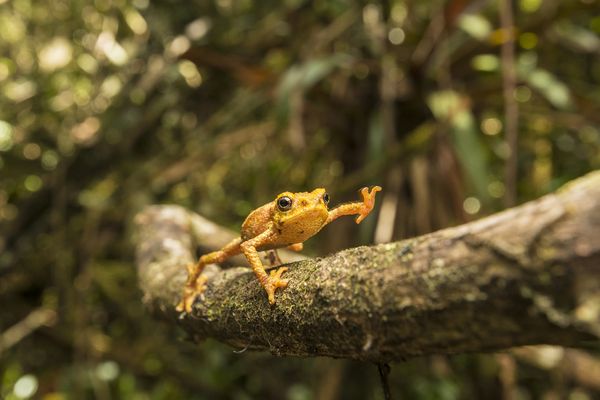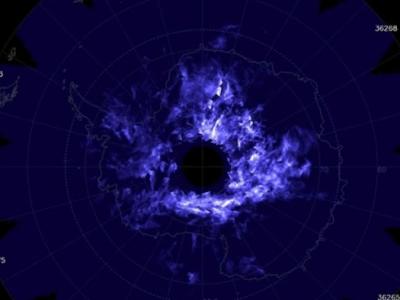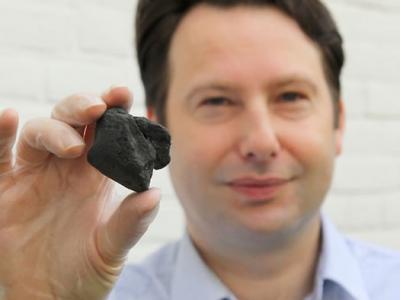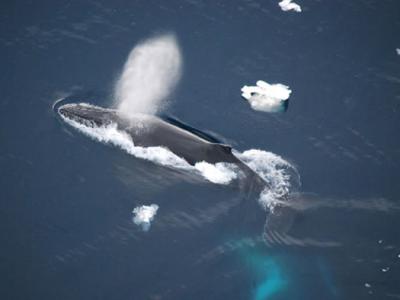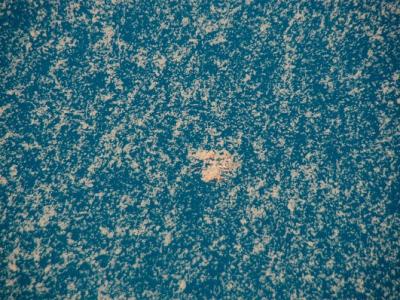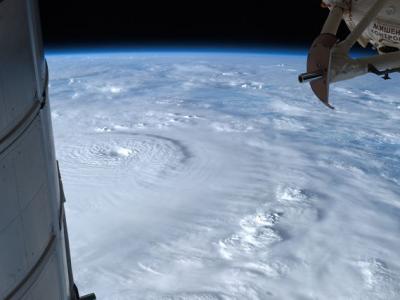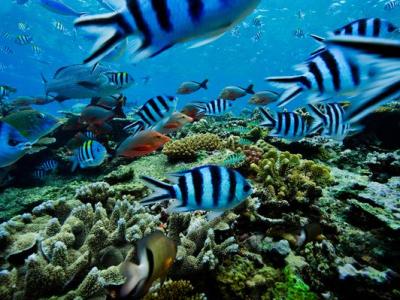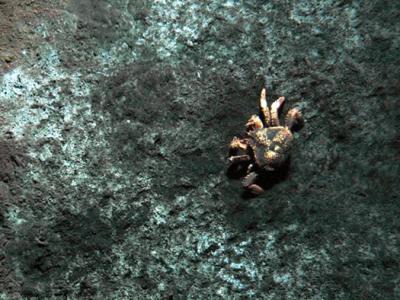Pristine "Islands in the Sky" Are Window on Evolution
South America's tepuis are populated with unique animals like the pebble toad.
Tepuis—high sandstone mesas that erupt from surrounding rain forest in southern Venezuela and part of adjacent Guyana and Brazil—have captivated scientists for centuries. Remote, ancient outcrops that soar up to 10,000 feet (3,000 meters) high, tepuis have long been thought of as crucibles of evolution. Recent research confirms their biological importance, but also shatters the most romantic notions about them.
Tepuis are widely cited as the inspiration for Sir Arthur Conan Doyle's The Lost World, and it's true that Victorian-era scientists had hoped to find intact prehistoric ecosystems on their summits, possibly complete with dinosaurs. That idea was even revisited in the 2009 Disney/Pixar film Up, in which a young boy and an elderly man meet a prehistoric-looking, flightless bird after their balloon-lofted house crashes on a tepui.
The filmmakers of Avatar "may have gotten the idea for those islands from tepuis, except they made them float," Bruce Means, a herpetologist and ecologist at Florida State University in Tallahassee, who studies the tabletop mountains, told National Geographic.
Tepuis are the real "islands in the sky," Means said, because their height—typically 5,000 to 10,000 feet (1,500 to 3,000 meters)—effectively cuts them off from the surrounding rain forest. That means they host unique habitats and unique creatures.
The rock that makes up tepuis is thought to be 1.6 to 1.8 billion years old, said Means, who has visited the mountains with support from National Geographic. Part of a vast region called the Guiana Shield, the mesas were uplifted around 40 to 50 million years ago, and then the surrounding rock eroded away. Scientists had assumed that erosion would have left plants and animals stranded on the summits, cut off from the surrounding landscape for tens of millions of years.
"So you would expect tepuis to have very ancient creatures," said Means. "It turns out that many of them do." The story turns out to have more twists than once thought, however, a realization revealed by Means and other researchers.
On Top of the Tepuis
The summits of tepuis are barren, rocky places, said Means. There is very little soil, because heavy tropical rains wash away everything that isn't solid rock. Trees and other vegetation can take hold only in protected cracks and gullies.
Lowland tropical forest surrounds the base of each tepui. Farther up, the vegetation that clings to their rocky sides changes, becoming cloud forest.
Even higher, at about 1,000 feet (300 meters), the mix of tropical animals and plants that can survive changes dramatically, said Means.
On a tepui summit, a scientist might find one or two species of frogs. In the cloud forest zone on the sides of the mountain, there might be 30 to 40 species. Those areas are poorly studied, because the only way to reach them is to climb, said Means. "Many have genera on them that may not be found on any other tepui, let alone anywhere else in the world," said Means, who added that tepui summits—at least in Venezuela—have been better studied than the slopes, because scientists have landed on several in helicopters.
The Mystery of Pebble Toads
To try and gauge exactly how cut off tepui dwellers are from their surroundings below, Means and colleagues homed in on pebble toads—small, colorful amphibians that are covered with bumps. Part of the genus Oreophrynella, pebble toads are an ancient group that split off from other toads many millions of years ago, during the time of the supercontinent of Gondwana, said Means.
Some of their closest relatives now live in cliffs in Africa, he added, an echo of the time when that continent was joined to South America. "Pebble toads have an extraordinary hind foot that has been modified for climbing," said Means. "They are like hands. Nothing else in the frog world is like it."
It is that climbing ability that has allowed pebble toads to be arboreal. "You don't expect to see a toad in the trees," said Means.
Over the past few years, Means has been visiting tepuis in Guyana to collect pebble toads. "We looked at their DNA and found that the differences between [frogs on] tepuis [are] very small, not the differences you would expect from animals that have been isolated from each other for a long time," Means said.
He concluded that there must have been more gene flow up and down tepuis than scientists had previously thought. Pebble toads on the summit had diverged from those at lower elevations "only a few tens of thousands of years ago, if that," said Means.
Means said it's possible that the small toads could climb along cracks in the mesas, even for thousands of feet. Climate change over the past few tens of thousands of years could have spurred them along, he suggested.
"I suspect that even if one of these frogs fell off a tepui, and fell a few thousand feet, it still might survive if it lands in the bushes, because they are very light," said Means.
In addition to pebble toads, Means has discovered an entirely new family of frogs on tepuis, with DNA unlike anything seen before. "It is a living fossil connecting frog families that have tadpoles with those that bypass the tadpole stage in the egg," said Means. He has also identified what he believes will turn out to be a new species of lizard.
Rich Plant Life
Erin Tripp, a botany professor at the University of Colorado, Boulder, who is studying the biodiversity of tepuis, added that the mountains tend to foster plants and animals with extreme adaptations. "Tepuis are some of the wettest places on Earth, with some getting up to 27 feet [9 meters] of rain per year," she said, noting that the wettest parts of continental North America get about 10 feet (3 meters) of rain a year.
"Their nearly pure-sand soils are extremely nutrient deficient," Tripp added about tepuis. "So what can grow in that environment? Your average petunia would be dead in 24 hours."
With support from National Geographic and others, Tripp has collected museum specimens and genetic samples from thousands of plants from northern South America, in an effort to help scientists understand the role that tepuis play in plant evolution.
Kenneth Wurdack, a botanist at the Smithsonian's National Museum of Natural History, has studied tepuis in Guyana and Venezuela, most recently in summer 2012 on a National Geographic/Waitt grant to visit Kamakusa Mountain with Tripp and others. Wurdack's scientist father had been part of the "high tepui-exploration period" of the 1950s, so he grew up fascinated with them.
"No helicopters could be hired in the 1950s. They had to climb up, so those trips would go on for months," Wurdack said.
Scientists started to map tepuis from the air in the late 1940s, said Wurdack. At that point they had been largely unexplored. Native people avoided them because of their harsh climate and rugged terrain, and because of local superstitions. But through the 1950s and 1960s, expeditions were launched from the U.S. to survey tepui biodiversity. In the 1970s, Venezuelan scientists started leading trips up the mesas. By the 1980s, scientists had started using helicopters to access the summits, although some tepuis have yet to be visited by any human beings.
Wurdack said that recent science suggests a complex picture of biodiversity on tepuis. Many of the mountains do have their own unique species, some of which seem to be most closely related to species on nearby tepuis. That's similar to the way species are distributed across island chains, he noted.
Tepuis also have species that are related to flora and fauna in the lowlands. "On tepuis the climate is harsher, so the plants evolved thick leaves or hairs to protect them," said Wurdack. He pointed to types of Podocarpus, an evergreen conifer that is sometimes used as a houseplant, as one common fixture on tepui heights.
The largest tepuis, such as Auyan-tepui in Venezuela—which hosts the spectacular Angel Falls (the world's tallest waterfall)—tend to have the highest number of unique species. (See: "Venezuela Photos.") Such endemic species are most likely to be living things that are less mobile, especially plants, but also small animals like reptiles and amphibians, Wurdack noted. There are very few, if any, birds unique to individual tepuis, and the small mammals thought to live on them are not well known.
Challenges and Threats
Studying tepuis has often been challenging politically, as well as logistically, Wurdack added. In the 1990s, South American governments restricted access to the region after the movie Arachnophobia was released "because they thought it portrayed the area in a negative light," he said.
And after Patrick Tierney's controversial 2000 book Darkness in El Dorado, Venezuela imposed further strict restrictions on scientists trying to study the tepuis. The book, though now largely discredited, had accused anthropologists of performing unethical experiments on and spreading measles to indigenous people in the tepui region in the 1960s.
But the effort required to study tepuis is worth it, said Wurdack, who noted, "Island-type systems like tepuis are very interesting as crucibles of evolution."
Tripp added that part of the scientific appeal of tepuis is they are relatively pristine, so researchers can study an ecosystem that is largely undisturbed by human activity.
Despite their remoteness and hardiness, plants and animals on tepuis do face challenges, especially from climate change, warned Wurdack. Each living thing is adapted to a particular zone. Plants and animals may be able to move up or down the mountain to some extent when the climate changes, but eventually they will run out of places to go.
Means added that some tepuis also face development pressure. Many are well protected in Venezuela, as part of a national park system. But in Guyana, there is less oversight.
"Tepuis can contain gold and diamonds, and people are tearing up the landscape to get at them," said Means. "They use hydraulic hoses, which can blast away rain forest, and they use mercury to amalgamate the gold, and it gets in the water."
He added that there is a lot of land that remains untouched, but that might not always be the case.
Wurdack said the film Up may inspire a new generation of scientists to explore tepuis, the way he had been inspired by The Lost World as a child. "Up did a good job of depicting the landscape, with weird sandstone outcrops and limited vegetation," he said.
Brian Clark Howard
National Geographic
Published September 28, 2013
